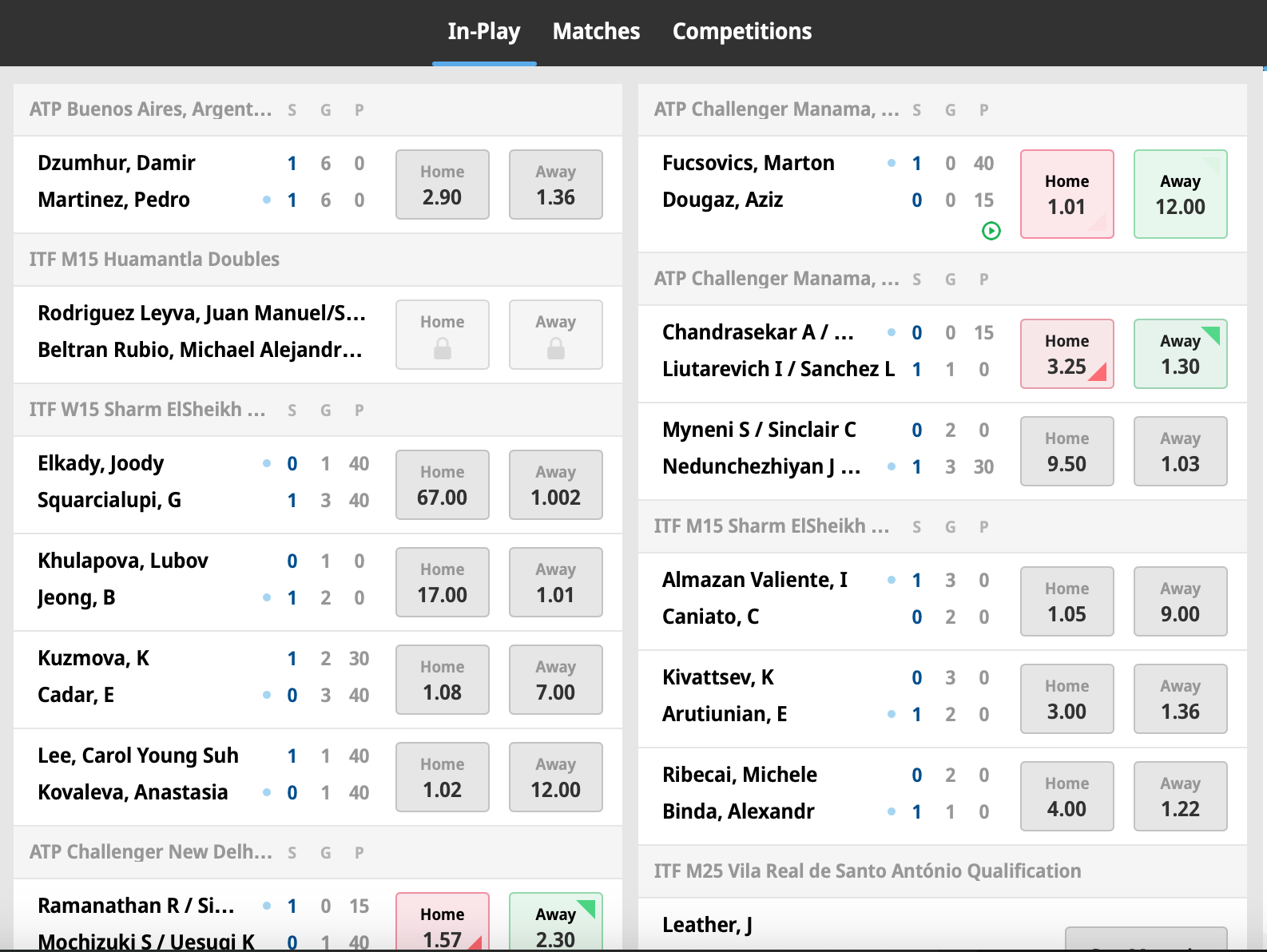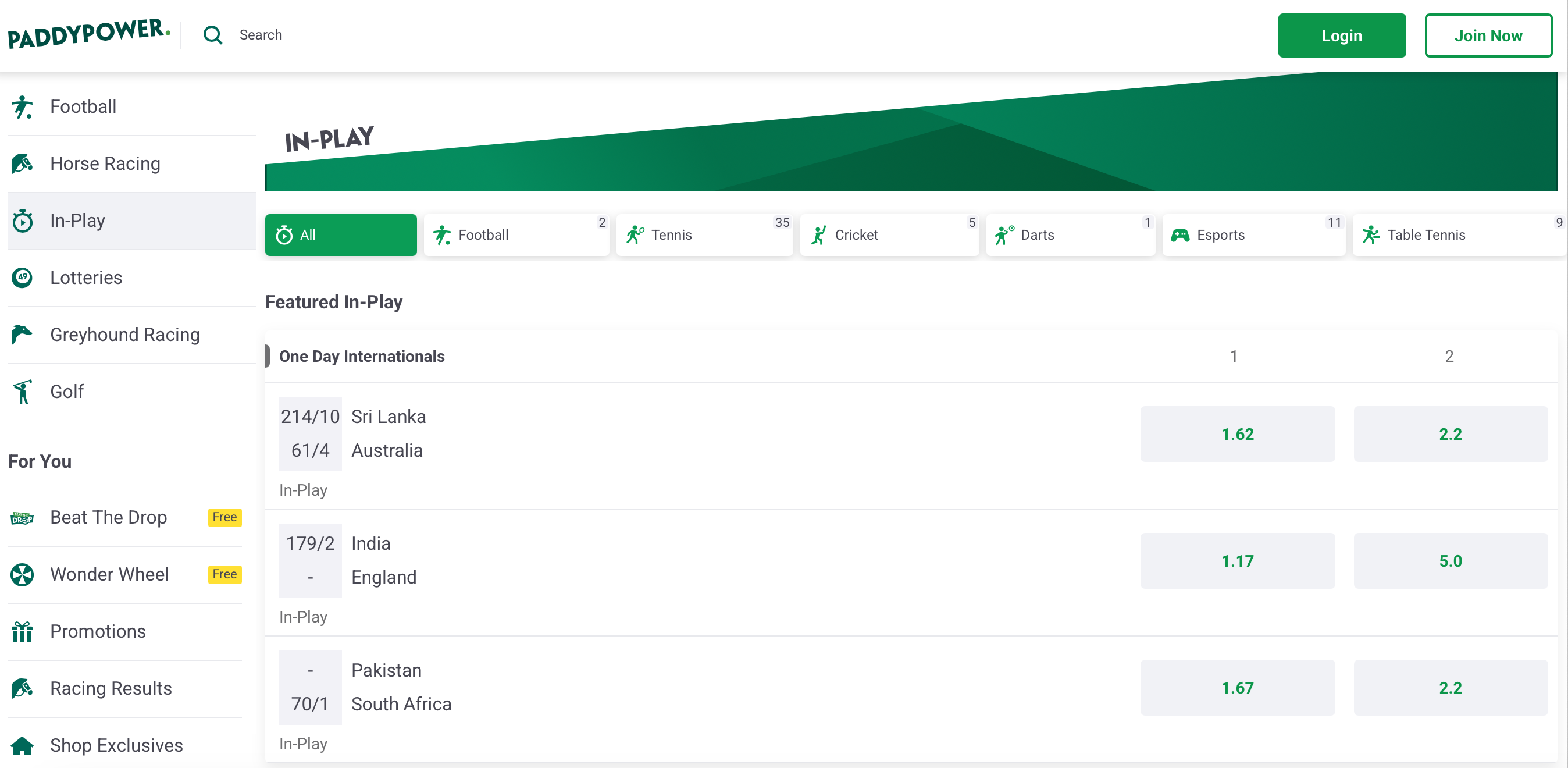A Guide To In-Play Odds
Many of us can find ourselves quite intimidated when we first try our hand at betting in-play, especially if we’re relatively new to sports betting.
Everything seems to happen so fast - and the moment you settle on a suitable selection, the odds change on you, leaving you to decide whether to accept worse odds or to start again from scratch.
With all this high-pace confusion, you could be forgiven for thinking in-play betting isn’t worth your while, and that the risks of ending up with a poor value bet are too high.
However, there are ways to take advantage of the in-play odds you see, while minimising the risk of unfortunate odds changes.
In this article, we’ll run you through how in-play odds work, and give you our best tips to get the most value for money out of in-play betting.
How Does In-Play Betting Work?

In-play betting (sometimes known as live betting) is, as it sounds, the practice of betting on an ongoing event.
It can apply to pretty much any sport (although not all bookies will have in-play markets for every sport, especially niche ones), including horse racing - though for racing-related sports, it can also be referred to as in-race betting.
Because you’re betting in the midst of the action, in-play betting is usually fast-paced, with the odds changing constantly depending on what’s going on in the game.
That means you’ll probably have to act quickly when you decide you want to place a bet, as the odds for your selection won’t stick around for long.
There’s often a delay on in-play bets being placed, which is designed to neutralise any advantage bettors may have if they’re physically present at a fixture, as opposed to watching a live feed, which is usually subject to a delay of a few seconds.
In-play betting hasn’t always been around, and even now not every bookie offers it. From a bookie’s view, it can be a logistical challenge to update odds as frequently as needed for an ongoing match or race, especially as they could compromise their profits if their software failed to keep up with events.
Usually, a bookie will therefore offer a limited range of in-play markets on an event, with less popular or more obscure markets being available only up to the start of the match or race.
They’ll also suspend some markets at crucial moments within a match (e.g. when a goal is scored, or when a red card is shown), so that it isn’t possible to bet for or against an event that might already have happened.
All this effort is well worth it, because in-play betting can be a huge money-spinner for bookies, and they will often heavily promote betting in-play, with many promotions being specific to in-play betting.

Not that they exactly have to persuade most bettors to get on board with in-play betting.
A lot of regular punters love to bet in-play, basing their decisions on small swings of momentum between the opposing sides - and many of those punters might not have the expertise or detachment to make the wisest choices, especially at moments of high excitement.
How Do Odds Work?
Odds in sports betting are based on the simple principle of telling the bettor how much they stand to win if their bet is successful. High odds mean they’ll win a large amount, while low odds mean a relatively small amount, when compared to their original stake.
Inevitably, odds also correspond (sometimes more loosely than others) to probability. A bookie is always going to be willing to pay out more if an outcome is considered unlikely to occur, and less for what is considered a highly likely outcome.
For this reason, odds can also be viewed as an indication of probability. Low odds indicate a high chance of something happening, whereas high odds indicate a low chance of something happening.
Of course, probability isn’t the only factor bookies use to determine their odds - they have to make a profit too. This is accomplished through their margin, a certain percentage added to a bookie’s odds to ensure a profit.
They’ll also adjust their odds to encourage customers to bet on particular selections, with the aim of achieving a balanced volume of bets on both (or all) sides of an event.
In-play odds work in exactly the same way, just at a much faster pace, which is why in-play betting can be such a dramatic, fast-paced activity.
Finding Good Odds In-Play

As with pre-match betting, finding good odds relies to a great extent on having knowledge and experience of the game.
It’s certainly wisest to watch the match or race live if you’re planning on betting in-play (something many bookies facilitate on their own sites), to ensure you understand what’s going on in the match and why the odds might be shifting.
It can be a good tactic to do your research in advance of a match or race, and to decide on what you think would be worth betting on at what odds.
Then when the event has started, you can wait to see odds that you’d consider good, depending on the way the game has gone, and immediately place a bet as soon as the odds hit that target.
Because in-play betting moves so quickly, it’s difficult to compare odds between all bookies to find the very best available, because the chances are they’ll have changed by the time you come to place your bet.
However, it is still possible to keep an eye on a smaller number of bookies, keeping track of whose odds tend to be the best, and choose your bookie on the grounds of which is usually offering odds at the higher end.
You might not manage to find the very best odds available anywhere, but you’re likely to end up with better than average odds.
Pitfalls Of In-Play Betting

The most obvious pitfall of in-play betting is the fact that everything moves so quickly. If you’re a bettor who likes to take their time, think through their decisions and double check their selections, you’re likely to find in-play betting a struggle.
Acting decisively is therefore necessary for successful in-play betting - but it can also be a risk. It can result in emotional rather than logical decision-making, which is rarely the most successful for sports betting.
Bettors can also find that the high pressure and excitement of in-play betting can make them more likely to fall prey to gambler’s fallacy, or to chasing their losses.
If you’ve placed a couple of in-play bets and then immediately seen their chances of winning drop, you’re at risk of falling into this trap.
In a desperate attempt to salvage your likely losses, you might end up making hasty, poorly thought out bets, which, if anything, are going to make your situation even worse.
If you’re going to engage in in-play betting, it’s wise to work out a plan before you start and then stick to it, to ensure you don’t make a decision in the heat of the moment that’s likely to be to your detriment.
In-Play Betting When Matched Betting
The fast-paced nature of in-play betting makes it much harder for matched bettors too.
You see quite a lot of in-play offers, and it’s natural to want to take advantage of those. But while play is ongoing, it’s often the case that what initially appears to be a great match will have shifted, sometimes substantially, between placing your back bet and lay bet.
Sometimes, this can be to your advantage - it’s perfectly possible for the odds to shift in your favour after your back bet, meaning you could end up with an arbitrage bet when you place your lay bet, resulting in an instant profit.
However, it’s just as possible for the odds to shift against you, meaning that you may no longer be available to find any kind of reasonable match at all.
In that scenario, you’re forced to choose between placing a lay bet that guarantees you a more substantial loss (or lower profit) than you’d like, or simply leaving your original bet and hoping that it goes on to win.
Of course, you could also wait and see if the odds shift back again over the course of the match - but as there’s no guarantee of that happening, this isn’t much better than leaving your original bet and hoping for the best.
There are ways to minimise this risk when Matched Betting in-play, though, which we’ll explain below.
Tips And Tricks To Get The Most Out Of In-Play Betting

Betting during half time/between sets
Especially if you’re Matched Betting, waiting until half time, or set breaks for sports like tennis, can be the best way to avoid running into issues caused by odds changes.
Although you’ll typically still see some odds movement during breaks in play, there’s much less going on, so those odds tend to be steadier.
Exploiting delays in odds changes
If you really know what you’re doing, there’s scope to capitalise on bookies being slow to update their odds in response to events in a game or race.
It must be said that this is definitely a tactic for experienced bettors, as you need to be in a position to confidently identify situations where a bookie hasn’t caught up with events.
However, if you know what you’re doing, there’s a lot of potential value to be had from getting one step ahead of the bookies.
This is why practices such as courtsiding (having a representative physically present at a game or match and passing on significant events before the odds can be updated) and steam chasing can be so profitable - and why bookies do their very best to prevent them.
Hedge betting
This is another tactic best used by experienced bettors, but the changes in odds over the course of a match can sometimes put you in a position to benefit from hedging an existing bet.
For example, if you’d placed a bet before the match on Chelsea to win, and Chelsea then go on to score the first goal, you might well find that you can bet in-play on their opponents at great odds, putting yourself in a position to profit from a win for either team.
This does depend on the course of a match or race, though, and it won’t always be possible to hedge your bet. Even so, once you’ve gained some experience of in-play betting, it’s worth keeping your eye out for hedging opportunities.
Summary
In-play odds are volatile and fast-moving, which can make in-play betting a stressful experience, especially for newer sports bettors. And if you’re Matched Betting, trying to find a close match that stays put long enough for you to back and lay it can be a real nightmare!
Betting during half time, or during breaks in play, can help to mitigate this problem - although the chances are you’ll still have to move fairly quickly.
For more experienced bettors, exploiting delays in odds changes or looking for opportunities for hedge betting can make for excellent value bets - but do be careful! In-play odds changes can result in rushed, emotional decision-making, which is never a good thing for your profit.
If you’d like to find out more about Matched Betting, check out our beginner’s guide or sign up for our free trial to start making profits today!
Updated: 15 May 2025
The Author
Stephanie is a published author and, having taken up Matched Betting fairly recently, she knows exactly how beginners feel when they first start Matched Betting. She loves breaking down complex subjects in straightforward terms to make them accessible to newcomers, and to speed them on their way to making their first profits.

